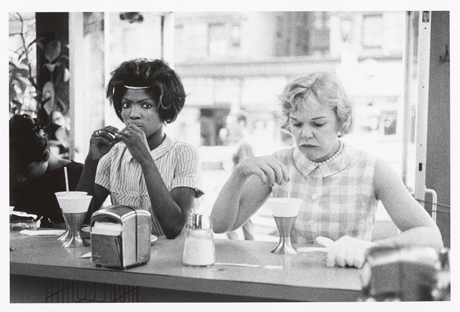Everything Was Moving: Photography from the 60s and 70s

USA. New York City. 1962. Black Americans. © Bruce Davidson / Magnum Photos
Whatever your taste in photography, as art, or journalism, as personal memoir or social documentary, do not miss the opportunity to see work by some of the most exciting photographers of the Twentieth Century at the Barbican Gallery’s exhibition, Everything was Moving: Photography from the 60s and 70s.
Here are some of the great names of contemporary photography, but I guess that there will be some that you will be less likely to know, as well as work not often seen before.
This is a massive show of over 400 pictures, with works from the USA by innovative colourist William Eggleston and Bruce Davidson’s gritty black and white documentation of the Civil Rights Movement. From South Africa, in very different circumstances David Goldblatt and Ernest Cole document the lives of communities lived under apartheid.
In the USSR Boris Mikhailov was subverting the image of the heroic Russian people, poking fun and experimenting playfully with sandwiched negatives, while in China Li Zhensheng was in the vanguard of the Cultural Revolution. A Red Colour News Soldier working on a paper he documented the excesses and violence of Mao’s ideological revolution, but when realisation came, buried away his negatives for 30 years.
In all, a dozen photographers’ work is represented. Work made in Asia, in America, in Africa and in Russia, but oddly not in Western Europe. The English photographer Larry Burrows whose well known photographs of Vietnam are shown and the German artist Sigmar Volke’s, whose devastatingly moving pictures of bear baiting in Afghanistan were a revelation.
Of course, in group exhibitions we can all play the game of, ‘Who would I have selected’, or ‘Who is missed out’, but it is hard to discern the reasoning behind some of the selections. Why for example are two photographers documenting South Africa and Malack Sidibe’s charming modern portraits from Mali chosen, but nothing from the whole of Europe which in the 60’s and 70’s was going through massive cultural, social and political change?
The Barbican’s curator, Kate Moss, has made a curious selection in her worldwide survey of photography from this time. It was a period when by and large the notion that photographs might be art on the walls of a museum gallery never occurred the establishment’s critics and curators. Moss says that the exhibition, “…asks if, in the early 21st century, we are finally prepared to erase the distinction between art photography and documentary photography”.
As someone who never thought it was legitimate distinction in the first place, I can confirm that the exhibition celebrates the greatness and diversity of photography as an expressive medium. Take the opportunity to re-acquaint or discover the work of all of the above along with the colourful Ganges modernism of Raghubir Singh, the surreal Mexican portraits of Graciela Iturbide and the books of the ‘godfather’ of modern Japanese photography Shomei Tomatsu, but don’t get too worried about what it all means.
Everything Was Moving: Photography from the 60s and 70s
Until 13 January 2013
Barbican Art Gallery
Silk Street
EC2Y 8DS
Tel: 020 7638 8891
